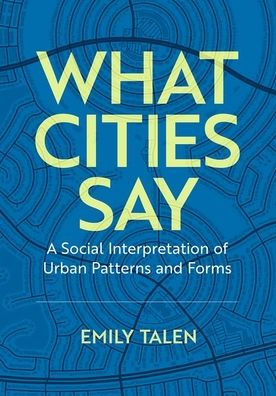Cities come in all shapes and sizes, with different patterns and forms. Streets might be strictly gridded or curvilinear. Buildings might be tightly packed or spread out. Patterns and forms might reflect the highest aspirations, or they might simply be responses to mundane, utilitarian needs. So what do cities "say" about a society? What do patterns and forms reveal about social priorities and cultural preferences, or about who has power and who does not?
In What Cities Say, Emily Talen provides a wide-ranging yet concise synthesis of the fundamental drivers of built form, its social and cultural meaning, and how we should interpret it. Including thirty-five distinct city patterns and forms, Talen develops a language of interpretation to understand the motive and meaning behind the city and its elements. Talen argues that meaning is often implicit, and even if it's more explicit, it is woven in haphazardly through city planning texts in often contradictory ways. To cut through the noise and ambiguity, she focuses on the persistent themes that inhere in built pattern and form, whether for complete cities or individual places. She makes ample use of digital resources to render these interpretations in explicit terms. By exposing these meanings, Talen asserts that we will be in a stronger position to articulate, and argue for, the kinds of cities we want. Richly illustrated and tightly presented, What Cities Say is essential reading for anyone interested in the values and ideas that serve as the foundation of how we construct our cities.
1145199320
In What Cities Say, Emily Talen provides a wide-ranging yet concise synthesis of the fundamental drivers of built form, its social and cultural meaning, and how we should interpret it. Including thirty-five distinct city patterns and forms, Talen develops a language of interpretation to understand the motive and meaning behind the city and its elements. Talen argues that meaning is often implicit, and even if it's more explicit, it is woven in haphazardly through city planning texts in often contradictory ways. To cut through the noise and ambiguity, she focuses on the persistent themes that inhere in built pattern and form, whether for complete cities or individual places. She makes ample use of digital resources to render these interpretations in explicit terms. By exposing these meanings, Talen asserts that we will be in a stronger position to articulate, and argue for, the kinds of cities we want. Richly illustrated and tightly presented, What Cities Say is essential reading for anyone interested in the values and ideas that serve as the foundation of how we construct our cities.
What Cities Say: A Social Interpretation of Urban Patterns and Forms
Cities come in all shapes and sizes, with different patterns and forms. Streets might be strictly gridded or curvilinear. Buildings might be tightly packed or spread out. Patterns and forms might reflect the highest aspirations, or they might simply be responses to mundane, utilitarian needs. So what do cities "say" about a society? What do patterns and forms reveal about social priorities and cultural preferences, or about who has power and who does not?
In What Cities Say, Emily Talen provides a wide-ranging yet concise synthesis of the fundamental drivers of built form, its social and cultural meaning, and how we should interpret it. Including thirty-five distinct city patterns and forms, Talen develops a language of interpretation to understand the motive and meaning behind the city and its elements. Talen argues that meaning is often implicit, and even if it's more explicit, it is woven in haphazardly through city planning texts in often contradictory ways. To cut through the noise and ambiguity, she focuses on the persistent themes that inhere in built pattern and form, whether for complete cities or individual places. She makes ample use of digital resources to render these interpretations in explicit terms. By exposing these meanings, Talen asserts that we will be in a stronger position to articulate, and argue for, the kinds of cities we want. Richly illustrated and tightly presented, What Cities Say is essential reading for anyone interested in the values and ideas that serve as the foundation of how we construct our cities.
In What Cities Say, Emily Talen provides a wide-ranging yet concise synthesis of the fundamental drivers of built form, its social and cultural meaning, and how we should interpret it. Including thirty-five distinct city patterns and forms, Talen develops a language of interpretation to understand the motive and meaning behind the city and its elements. Talen argues that meaning is often implicit, and even if it's more explicit, it is woven in haphazardly through city planning texts in often contradictory ways. To cut through the noise and ambiguity, she focuses on the persistent themes that inhere in built pattern and form, whether for complete cities or individual places. She makes ample use of digital resources to render these interpretations in explicit terms. By exposing these meanings, Talen asserts that we will be in a stronger position to articulate, and argue for, the kinds of cities we want. Richly illustrated and tightly presented, What Cities Say is essential reading for anyone interested in the values and ideas that serve as the foundation of how we construct our cities.
27.95
In Stock
5
1

What Cities Say: A Social Interpretation of Urban Patterns and Forms
312
What Cities Say: A Social Interpretation of Urban Patterns and Forms
312
27.95
In Stock

Product Details
| ISBN-13: | 9780197647776 |
|---|---|
| Publisher: | Oxford University Press |
| Publication date: | 07/25/2024 |
| Pages: | 312 |
| Product dimensions: | 7.03(w) x 9.98(h) x 0.69(d) |
About the Author
From the B&N Reads Blog
